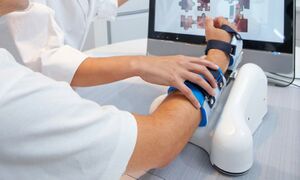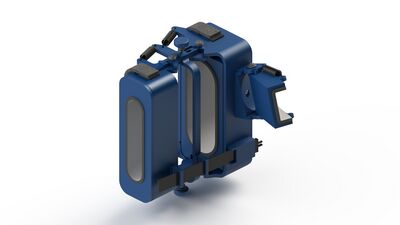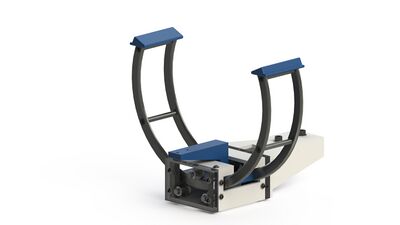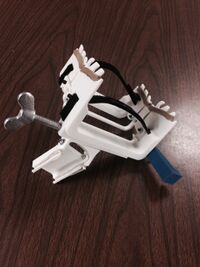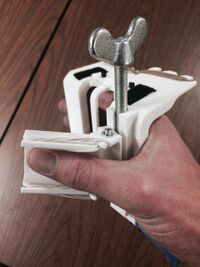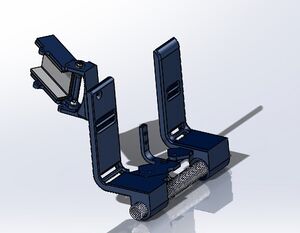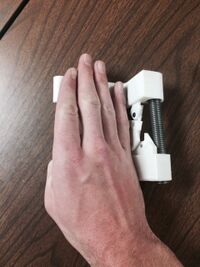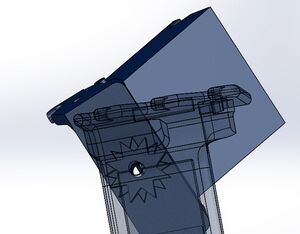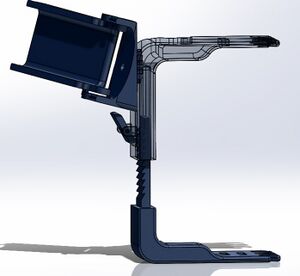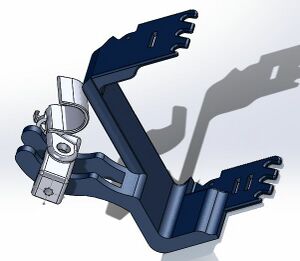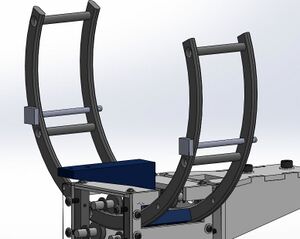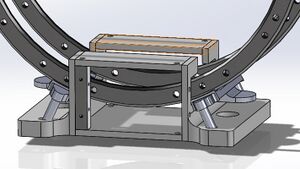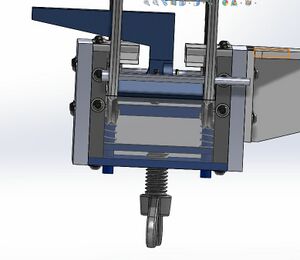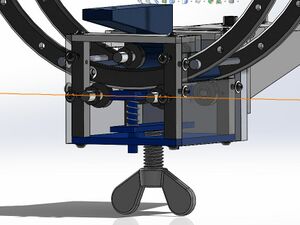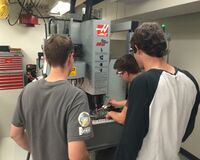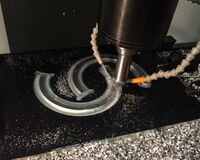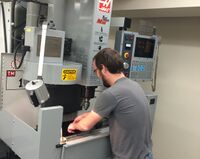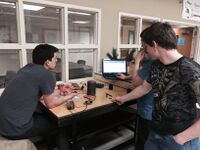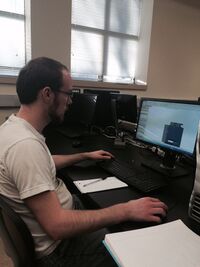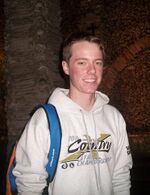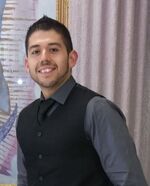Robotic Arm Rehabilitation Device
| 2014 University of Idaho Capstone Senior Project | |
|---|---|
| Tecnalia's prototype robot [1] | |
| Sponsors | |
| Team Name | Rehab |
| Duration | Fall 2014 - Spring 2015 |
| Tecnalia Representative | Aitor Belloso Linacisoro |
| Faculty Advisor/Mentor | Dr. Joel Perry |
| Team Members | Calvin Connor, Brandon Wade, Ronnie Ross, Ryan Clark, Tony Totorica, Adrian Alcocer |
| Questions or Comments? | email Brandon Wade at wade3156@vandals.uidaho.edu |
Assisting Tecnalia's venture in designing a rehabilitation robot to aid stroke victims in their recovery. Our aim is to further improve Team Arm Assist's two previous add-on modules by implementing advancements to create a more fluid, functional product.
Development and Project Goals
TECNALIA's Arm Assist Robot is an assistive robot for the rehabilitation of patients with upper limb neuromuscular impairment, specifically for patients who have suffered from a stroke. This assistive robot is accompanied by a tele-rehabilitation platform, thus allowing rehabilitation at home under supervision from the therapist by its quantitative evaluation.
ARMASSIST represents a major technological breakthrough which allows TECNALIA to address the growing market demand for personalized care. This initiative was born to meet the needs of the 15 million people who suffer brain-vascular damage every year; of that figure 5 million suffer permanent disability.[[2]]
The Robotic Arm Assist team, provided by the University of Idaho, will work through the capstone project to further develop the rehabilitation robot. The team will add to the overall functionality of the robot by providing TECNALIA with modules that will increase the ability to rotate the wrist and ability to open and close the patient's hand.
Problem Definition
Our goal is to evaluate the 2013 Team Arm Assist's modules and make further improvements. We are primarily focused on the advancing the functionality of the wrist and grip module to create a universal product that can be powered comfortably by any user. Our improved modules should be durable, increase adjustability, and ensure accurate results to guide the patient to recovery.
Background
Our team, Team Rehab, is continuing the Robotic Arm Assist project from the 2013 team.[[3]] Team Arm Assist designed three add on modules that consisted of a grip, wrist rotation, and arm elevation module. At Tecnalia's request, they want us to further implement advancements to the grip and wrist rotation module while the company will be finding a more efficient design for the arm elevation module.
Last year's prototype lacked in a few areas that need further development. Aside from the lift module, the main areas that can be increased within the grip module include adjustability to accustom all hand sizes, implement a sensor to measure force and degrees in grasp, and create an adjustable system to change the resistance. The previous year's sensor gathered poor and inconsistent data. Therefore, it is our goal to design an efficient method to test the force and degrees of grasp so that the data will be consistent and concise with every user. To the right, is the final design of the grip module that we will improve.
In the wrist module, the primary characteristics to be improved include incorporating a locking mechanism to prevent pronosupination, add a gyroscope to calculate degrees of rotation, and design soft stop ends at the end of rotation. The picture on the right includes last year's design. The blue acrylic piece in the center is where the grip module mounts and is then allowed to freely rotate via two aluminum rails. The stops on either end are hard plastic that abruptly stops pronosupination of the wrist which is sought out to become absorbed from a design by this year's team.
Project Needs
When determining the necessity of each improvement that was specified by Tecnalia, we assembled a metric matrix that listed all the needs and the level of priority. Below is the following list that decided where we need to focus and put most of our effort into to fully satisfy our client. The scale in which the priority was rated by Tecnalia was on a scale from 1 to 5. 5 - Must have. 3 - Desirable. 1 - Luxury.
|
Module |
Needs |
Priority |
Measurables |
| Grip/Wrist | easily integrated into system | 5 | Dimensionally compatible with current system |
| Grip/Wrist | improved adjustability of modules | 5 | Fits at least 95 to 5 percentile of human hand/wrist dimensions |
| Wrist | Adjustable grasp extension support | 5 | Grip module can be adjusted to fit a wide range of hands |
| Wrist | Adjustable degrees of motion | 4 | At least 2-3 discreet ranges of motion (multiple settings, 120deg, 80 deg,etc.) along with complete free movement |
| Grip/Wrist | Low cost manufacturing | 4 | No more than $250 per prototyped module |
| Grip/Wrist | Improved assembly process | 4 | Assembly time should take no more than rebuild time of previous model |
| Grip/Wrist | Simple/cost effective technology | 5 | Use low cost sensors and always consult the client for the economical decision |
| Grip | Accurate/repeatable grip force readings | 5 | 30 trial tests are not statistically significant in difference |
| Wrist | Accurate/repeatable rotation readings | 5 | 30 trial tests are not statistically significant in difference |
| Grip/Wrist | Easy/dependable calibration | 4 | Zero point calibration can be performed |
| Grip/Wrist | Intuitive human interface | 3 | Unfamiliar persons can use with basic directions |
| Grip/Wrist | Full stress analysis of designs | 3 | FEA using estimated forces during use |
| Grip/Wrist | Minimum size change of modules | 3 | No larger than the previous modules |
| Grip/Wrist | Patient comfort/ergonomics | 5 | No less comfortable than previous modules based on user feedback |
| Wrist | Assisted rotation | 3 | Help patient complete task by allowing very low friction in free movement |
| Grip | Assisted gripping | 4 | Help patient complete task by keeping hand open at rest |
Specifications
Grip Module
- Measure force of grasping and achieve accurate/consistent feedback
- Make universal by providing adjustability to accustom all users
- Provide comfort and simulate natural human biomechanics of the hand
Wrist Module
- Allow full range of motion in wrist (±90°ideally)
- Incorporate smoother stops at end of pronosupination
- Create a locking mechanism to prevent movement in wrist
- Integrate calibration system to record the degrees of rotation.
Project Learning
The process of implementing new improvements at the request of Tecnalia has entailed a lot of research from the previous year's results. There was a learning period where we had to quickly become up to date where Team Arm Assist (2013)[[4]] had finished. This included heavily examining their project portfolio to see where they succeeded and where there was potential improvement. Since their final add on modules were in Spain, we had to fully recreate the wrist and grip module from scratch. This entailed understanding Team Arm Assist's assembly plan, function of each mechanical part, and where there were was error in final calculations.
Since we had to recreate their previous modules, we were able to become proficient with the machine shop tools and the 3D printer MakerBot. As we have constructed and machined parts from their final design, there has already been areas where we have found that can be simplified and further improved.
Assembly Process
Machine Shop
- To speed up machining time:
- Reduce tool changes
- Avoid re-zeroing- there are also faster (less accurate) techniques to zero such as running the cutting bit on to just barely cut the surface for non-critical dimensions
- The attachment technique of the part is critical for the machining process- e.g. for press fit parts, the tolerances are very tight
- 3-d printed parts have bad tolerances (done here) so you may have to adjust dimensions to fit the printed part
Grip Module
- Thumb piece is difficult to attach and becomes loose after a few minutes of use.
- The pin used to adjust the length is too small and breaks easily.
- Springs on the thumb piece rub against the sides of the part.
- It has to be screwed into the pronosupination module and cannot be used separately.
- The grip has a rigid plastic on the back of the hand which limits adjustability and comfort for patients.
Wrist Module
- Grip module rubs against the box used to mount the pronosupination module
- The rings takes up a lot of space and could be reduced in size
- Certain components of the base could be combined to reduce the assembly process time and increase simplicity.
- The stops at the end of the rails need improvement to make an easier and smoother stopping motion at the end of pronosupination.
- Needs to improve design and create more space for sensors within the base.
Analysis of Previous Modules
Grip Module
- The thumb piece was uncomfortable, the springs provided poor resistance, and lacked the ability to adjust to different sized hands.
- Rigid back side of hand is uncomfortable and inhibits easy access of patient.
- Force sensor readings are inconsistent and unreliable.
- Material in various locations needs to be strengthened.
- Springs provide reasonable assistance for opening hand but are not adjustable.
Wrist Module
- Pronosupination of the forearm is natural and can be used by all size patients.
- The stops at the end of rotation are hard and need to be softer.
- Needs to incorporate a system to limit the degrees of rotation.
- Needs resistance and assistance.
Sensors
To provide real time data on motion and positioning, several sensors along with a dedicated microcontroller have been integrated into the modules and ArmAssist system. A quick search reveals a wide variety of sensors that monitor different types of motion. Implementing the correct sensor required extensive research into each sensors capabilities. The result is two rotary encoder sensors in the grip module to measure angular position and speed, along with a gyroscope in the wrist module capable of reporting orientation and measuring rotation of the module. These sensors are monitored and read by a Beaglebone microcontroller.
- Learn more: Rotary Encoder [[5]]
- Learn more: Gyroscope [[6]]
- Learn more: Beaglebone [[7]]
Grip Concept Development
The prototype on the left and right has a rigid frame that has an open back allowing easy accessibility for the patient. There are straps that keep the hand in place while simultaneously providing more comfort than a rigid back. This design also includes the opportunity to change various size bands to allow different forces to adjust to the patient's strength. The thumb is adjustable vertically to adapt to different sized hands. By rotating the wingnut screw, the patient or therapist and either lower or rise the thumb to the most comfortable position.
This prototype uses a cut to length extension spring that provides resistance when fingers undergo flexion. It only uses one joint on the one side to incorporate simplicity. Like the previous design, it contains an open back strap design to provide ultimate comfort and accessibility.
This design incorporates vertical adjustment as well as rotation about that perpendicular axis to obtain variable thumb positions. Using a ratchet mechanism, the patient or therapist can lift up the thumb piece and rotate it to its desired position and release to lock in place.
The design on the left is a prototype that achieves a larger range of motion for the thumb. The curved rails allow the thumb piece to rotate enabling the user to flex their thumb at different angles and positions. This prototype was developed to determine if the various thumb positions and overall design mimic natural thumb movement. Designs for incorporating resistance are currently being developed.
Wrist Concept Development
An idea to limit the degrees of rotation of pronosupination includes pins that can be adjusted throughout the ring. This will allow patients and therapists to lock the pronosupination in place to focus on the flexion of the hand in the neutral, pronated, and supinated position. Also, to provide resistance for pronosupination we created brake pads that can be adjustable by applying a range of forces via a screw.
This second brake pad design uses one brake pad that is applied directly from the bottom of the wrist module. This simplifies the previous design by incorporating only one point of application versus two different brakes. To compensate for the tolerances of the ring system, springs were introduced to apply a constant force for fluid rotation.
Final Product
Pronosupination Module
The final pronosupination module incorporates stronger material in which we machined instead of 3D printed. This ensures that the module functions properly and is long lasting for repeated use. Also, a compact roller system was implemented to provide resistance in the rotation of the forearm. With the tightening and loosening of the wing nut, the user can increase or decrease the amount of resistance. In order to simplify assembly, some of the parts were 3D printed together to minimize the assembly time and to simplify the add-on module. In order to select the amount of rotation, we created adjustable stops that can be placed anywhere along the rings to positions desired by the user.
Grip Module
The final grip module incorporates a hook and band system that allows the user to change resistances. This can be accomplished by setting the bands to different lengths or increasing/decreasing the size of the band. Straps were added to provide easy accessibility and to ensure full comfort. To improve on the rigid body structure, we implemented some curves to make it feel more ergonomic for the patient. Iterating last years prototype, we completely changed the thumb so that the resistance can be changed as well as the orientation in which the thumb closes.
Document Archive of Assembly Process
|
Wrist Module |
||||
| Ryan, Sam, and Brandon operating the CNC machine | Calvin and Sam discussing machine plan | Aluminum rails being chamfered by the CNC machine | Ronnie tapping holes into the rails | |
| Sensor Testing | ||||
| Tony, Adrian, and Calvin testing pressure sensors | Ronnie recording data |
Consultants
Dr. Joel Perry
Project Manager - TECNALIA, Rehabilitaiton Technologies Dept., Health Division
Adjunct Faculty - University of Idaho, Mechanical Engineering
Samuel Qualls
Fall Semester Graduate Student Mentor
Team Information
| Team Rehab: Brandon, Ryan, Tony, Calvin, Ronnie, and Adrian |
|---|
| Ronnie Ross | Hobbies and Interests: Ronnie enjoys playing the drums, video games, outdoor adventures, and skydiving.
| |
| Mechanical Engineering Student | ||
| Hometown: Coeur D'Alene, Idaho | ||
| Email: ross2497@vandals.uidaho.edu | ||
| Brandon Wade | Hobbies and Interests: Brandon is very passionate about helping others in the medical field. He is involved by volunteering at local hospitals and clinics as well as being philanthropic through his fraternity, Alpha Kappa Lambda. In his free time, Brandon enjoys cross country skiing, mountain biking, and anything that pertains to the outdoors.
| |
| Biological Systems Engineering Student | ||
| Hometown: Sun Valley, Idaho | ||
| Email: wade3156@vandals.uidaho.edu | ||
| Ryan Clark | Hobbies and Interests: Ryan's academic interests lie mainly in fluid dynamics and CAD modeling. During Ryan's free time, he enjoys hunting, fishing, and riding dirt bikes.
Plan for Future: While Ryan would like to get a job in the space travel industry, he would not mind getting a job that travels the world. | |
| Mechanical Engineering Student | ||
| Hometown: Salmon, Idaho | ||
| Email: clar6812@vandals.uidaho.edu | ||
| Tony Totorica | Hobbies and Interests: In Tony's free time, he enjoys playing soccer, reading, and live music.
| |
| Electrical Engineering Student | ||
| Hometown: Boise, Idaho | ||
| Email: toto6863@vandals.uidaho.edu | ||
| Calvin Connor | Hobbies and Interests: Calvin has a passion for welding and has taken some metallic material classes to help develop a technical background of the materials to support his experience. Outside of school, Calvin plays rugby with U Idaho men’s club and enjoys fishing, hiking, and general outdoors activities.
Plan for Future: Calvin plans on working in the aerospace or power generation industry for a few years to gain his professional engineering license. When possible Calvin would like to donate his time to the Engineers Without Borders as a professional member. | |
| Mechanical Engineering Student | ||
| Hometown: Boise, Idaho | ||
| Email: conn1018@vandals.uidaho.edu | ||
| Adrian Alcocer | Hobbies and Interests: During Adrian's free time, he likes to work out, cook good food, and be social.
Plan for Future: Adrian would like to pursue a career in the biomedical field where he would follow his passion for Molecular Biology and Engineering. | |
| Biological Systems Engineering Student | ||
| Hometown: Grandview, Washington | ||
| Email: alco0989@vandals.uidaho.edu |
Team Documents
Drop Box Link: [[8]]
Meetings
|
Team meetings: |
Mondays, Wednesdays, and Fridays at 2:00pm, Design Suite GJ |
| Team meetings with Mentor: | Mondays at 2:00pm, Design Suite GJ |
| Sponsor meetings: | As necessary, ME Conference Room |
